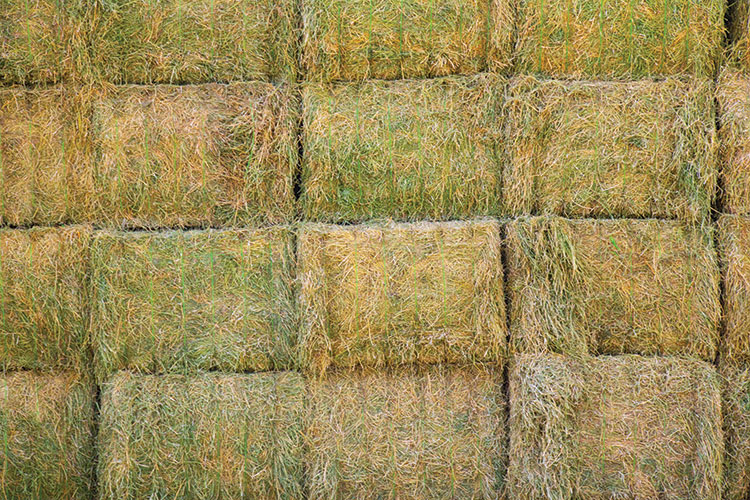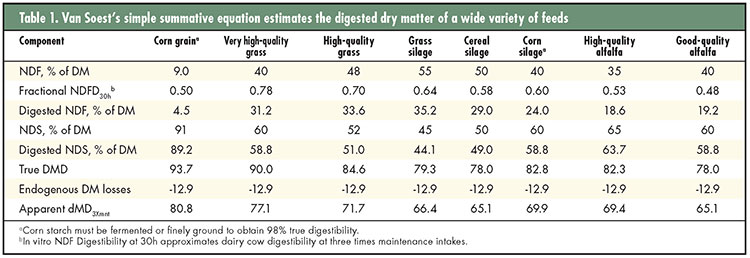Editor’s note: This is the second of three columns by the authors who will attempt to address the many issues associated with putting a value on alfalfa hay and haylage.

In the first article of this three-part series, we described the immense economic impact and importance that alfalfa hay and haylage has for growers and farms. With rising water costs in the West, and winterkill and growing season challenges in the Midwest and East, this value has only increased. As a result, appropriately valuing every ton of forage is critical.
Total digestible nutrients (TDN, %) are at the root of every hay valuation in one way or another. For relative feed value (RFV) and relative forage quality (RFQ), TDN is an intermediate in the calculations. For many in California (CA), the CA TDN attempts to predict TDN based upon just one nutrient measure, acid detergent fiber (ADF). These regression equations have to assume that ADF negatively affects TDN by the same amount regardless of the source or composition of the ADF.
Here’s the problem
In our last article, we indicated that the equation for CA TDN was roughly (82.4 – 0.75*ADF). The equation indicates that every percentage of ADF reduces TDN by 0.75 units. The problem is that the regression coefficient (- 0.75) is not a constant and varies with the set of data used to estimate it. The value varies considerably depending on the type of forage, the animal used to measure TDN, and the samples of forages included in the data set. Hence, ADF-based TDN predictions are not reasonable for today’s dairy or beef applications.
When Cornell University’s Peter Van Soest developed the neutral detergent fiber (NDF) method in the 1960s, he taught that digested dry matter (dDM; energy value) could be determined as the sum of digested NDF (dNDF) and digested neutral detergent solubles (dNDS). Thus, a simple summative equation could explain the dDM of forages: dDM = digested NDF + digested NDS.
The digested NDF is the critical point to focus on. Digested NDF is the product of NDF and its NDF digestibility (NDFD), and Van Soest also observed that NDS (all the non-fiber fractions of a feed) had a uniform and high true digestibility (in hay): dNDS = 0.98*NDS – 12.9.
The coefficient 0.98 is the true digestibility of NDS, at maintenance levels of feed intake. The coefficient -12.9 is the endogenous losses of microbial matter, intestinal secretions, and cell sloughing when no feed is eaten.
Thus, the first simple summative equation from Van Soest can be written as:
dDM = NDF*NDFD + 0.98*NDS – 12.9.
Because NDS = 100 – NDF, the equation simplifies to:
dDM = NDF*NDFD + 0.98*(100 – NDF) – 12.9.
This equation suggests that only two factors have a major effect on dDM: NDF and its digestibility (NDFD).
Both NDF and NDFD are needed
The simple summative equation works quite well for a wide variety of feeds (Table 1). Note that it shows that high-quality grass and alfalfa can have similar dDM, but they achieve their overall digestibility in different ways. Alfalfa is digestible because it is low in NDF, but its NDFD is actually lower than grasses. Although it is higher in NDF, grass can have comparable dDM to alfalfa because its NDFD is higher. This explains why it is difficult to compare forages of different types because both NDF content and NDFD must be considered. Neither should be used alone.

Researchers at The Ohio State University modified the summative approach for the estimation of TDN. Because TDN is ash-free, this solved one of the inaccuracies in the simple approach. They also divided the NDS into its components (crude protein, fatty acids, and non-fiber carbohydrates) and used individual true digestibilities for each. They estimated NDFD from lignin and suggested that it could also be determined by in vitro methods.
Their approach was adopted by the National Research Council in the “Nutrient Requirements of Dairy Cattle” (NRC, 2001). These different calculations of total digestible nutrients (TDN) and energy values, from simple to complex, have introduced confusion in determining the appropriate value of hay per ton. To avoid confusion, but to understand why CA TDN and RFV are shorting you in appropriately valuing your hay, consider analogizing to this situation in a card game:
Imagine you are sitting down to play cards with your friends or family and recognize that you haven’t been dealt a full hand in your favorite card game. You would likely call for a misdeal and reset the game to be sure you’re playing with a full hand of cards. Evaluating hay quality using the most simplistic estimates of TDN based on ADF, such as CA TDN or RFV, can be equated to playing shorthanded.
Don’t play shorthanded
Over the past 15 years, nutrition analysis has evolved such that many measurements can be considered when estimating TDN. Advanced nutrition models, such as the Cornell Net Carbohydrate and Protein System (CNCPS), estimate TDN from numerous feed fractions and their rates of digestion. Most nutritionists no longer use forage analysis TDN values in ration formulation, but instead enter complex forage nutrition information into the programs and allow the models to calculate an accurate TDN for the diet.
Table 2 details the nutrient measures accounted for with different TDN calculations reported by forage testing laboratories. Considering more nutrition information for TDN can improve hay evaluation and your purchasing decisions. Recognize that CA TDN and RFV account for considerably less nutrition information than other RFQ or NRC approaches, and they leave you with a short hand in making buying decisions.

The shorthanded evaluation concept was partly discussed in the prior article, in regards to one such example with soil contamination and ash content. In Table 2, you can see that ash and soil contamination is not considered with RFV. Heavy soil contamination in your forage could undermine the value proposition if you use RFV to buy or sell hay. Ash is taken into account with RFQ and TDN approaches. Another very important forage quality aspect to account for is NDFD.
The simple summative equation shows that NDF concentration and its NDFD are the predominant factors affecting dDM and TDN in hay and haylage. Not only is NDF fiber the least digestible fraction of a feed, but it also has the greatest range in digestibility. For example, two hay samples with around 45% fiber (aNDF) can range from 35% to 55% total tract NDF digestibility (TTNDFD). This range equates to a 9-unit difference in TDN.
This range in TDN and the economic value it represents needs to be accounted for. In vitro NDFD at 30 hours (NDFD30, % aNDF) represents an estimate for fiber digestibility, which depends on the accuracy and consistency of the in vitro method. With good methods, experience has shown that in vitro digestibility is more accurate than using lignin to estimate NDFD. Ruminal microorganisms can detect differences in NDFD that are not related to lignin.
Given similar in vitro methods, it seems reasonable that adding more fermentation times to the calculation would compensate for variation in any single NDFD30. The TTNDFD approach uses times of 24, 30, and 48 hours to estimate digestion rate (kd) and undigested NDF240 (uNDF at 240 hours) to determine the undigested fraction. The kd, uNDF240, and passage rate (kp) can be combined in an equation to estimate TTNDFD.
Work with your nutritionist to understand how uNDF240 and fiber digestion rate can be combined into TTNDFD and accounted for. Build more nutrition information into your hay or haylage valuation and decision-making process, avoid the simple TDN measures and making buying decisions that are shorthanded.
In future issues:
November: Avoid buying or selling hay based on noise
This article appeared in the August/September 2020 issue of Hay & Forage Grower on pages 30 and 31.
Not a subscriber? Click to get the print magazine

